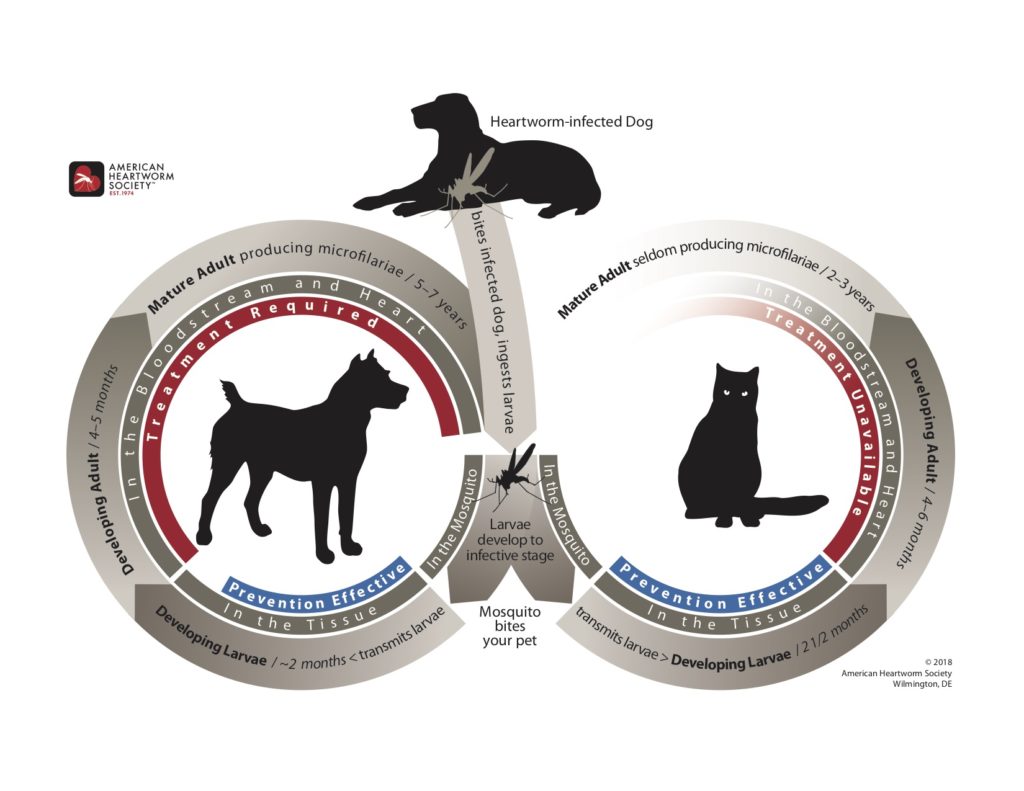Is heartworm prevention really necessary? The summer is soon to be upon us, and with the coming of the sun, we often find a higher instance of infectious diseases spreading through wildlife and insects. In plain terms, the bugs are out as much as we are, and it’s up to us to keep ourselves and our furry buddies safe and secure against transmittable diseases. Mosquitoes are pests at the best of times, but they also spread nasty viruses, diseases, and infections from animal to animal. Just as humans are told to get their flu shots every year for the protection it can give, animals have their recommended yearly – and monthly – preventives.
It may seem somewhat overkill to use preventatives every month for your dog, cat, ferret, or other various critters, but there are longevity issues with certain medications, such a flea, and tick or heartworm preventatives. These medicines are most effective for a certain period of time, generally 30 days, and then must be reapplied to remain at an effective dosage for prevention. Your veterinarian can explain more about the effective dosage for your pet at your next annual visit. By keeping to a regular dosing schedule, you give your dog the best chance at being fully protected at all times.
Protected from What?
Most pet owners think that as long as their pet is inside, there’s no threat of disease or infection. This isn’t entirely true, though the exposure to many diseases does decrease when a cat or dog spends more time indoors than out. Outside is where the wild things are: foxes, coyotes, wolves, prairie dogs and more all can carry worms, ticks, fleas (which can carry Plague, even today) and rabies, just to name a few. Each of these are pests that can be both prevented and easily treated if caught early enough.
In this first post, we’re going to talk about Heartworm disease, and why it’s such a threat, especially to dogs. Heartworm disease affects mammals of different kinds, most notably canines, but even as sea lions can have them. In very rare cases, heartworms have occurred in humans, but those cases were very rare and the heartworms didn’t develop into full adult worms.

Heartworm Life Cycle in Dogs
The life cycle of the heartworm starts and spreads through mosquitoes. A mosquito bites an infected animal, such as a coyote or other dog, and picks up microscopic baby heartworms from the host. This stage, called the microfilaria stage, then requires an incubation period of 7-14 days inside the mosquito before it can be transmitted to another animal. The infected mosquito bites your dog, depositing the larval worms onto the skin around the bite. The larval worms enter the bloodstream, where they live, maturing into the reproductive stage for the next 6-7 months. After they reproduce and reach full maturity, the worms migrate to the tissues of the heart and lungs, including the arteries and surrounding tissues. Adult worms grow to be over a foot long, and a dog may harbor as many as a hundred or so worms at a time, if left untreated.
Heartworms are more prevalent in the Southern United States than in the more coastal and desert areas, due to its spread through mosquitoes. That being said, there have been positive tests for heartworms performed in all 50 states, including Alaska and Hawaii. This is because many people bring infected dogs with them across the country when travelling for both pleasure and relocation. In Colorado, the instance of heartworms has risen dramatically in the last decade due to this influx of infected dogs from other areas. There was an especially large influx after hurricane Katrina, when 250,000 pets were adopted out across the nation from the worst hit areas, many of those pets already infected with heartworms.
Heartworm Prevention and Treatment in Dogs
The thing to remember with heartworm disease is that prevention is the best cure. Never having worms at all is the best possible outcome for a dog, but there are several treatable stages of heartworms. Usually diagnosed in 4 stages, heartworm disease starts off slowly with the microfilaria stage, which causes no noticeable symptoms. In the second and third stages, in which the worms grow and mature, there can be symptoms present in the infected dog: labored breathing, low energy, and an intermittent cough. The worms affect the tissues surrounding the heart and lungs, which causes problems with blood flow, blood oxygenation, and breathing. If left untreated, the disease always leads to death.
In the fourth stage, called the caval stage, adult worms start to overrun the heart tissues and die off, which can create cardiovascular collapse. This stage is marked by labored breathing, pale gums, coffee-colored or bloody urine, as well as sometimes swelling in the abdomen from fluid buildup. If your dog exhibits any of these signs, get him to the vet right away. The only treatment at the caval stage is surgery, which is still very risky, with limited good outcomes. The treatment requires extensive bloodwork, tests, and pre-operative care which can cost upwards of $1000. The treatment itself is expensive, and the recovery time is months to years, with many dogs never fully recovering.
Monthly preventative treatment costs from $30-$80 a year depending on your dog’s weight, and the type of preventative. There are monthly pills, both chewable and non, as well as topical creams. There is a six-month injectable as well, which can be a great choice for some. Ask your veterinarian what their recommended preventative is for your pooch! And remember: most preventatives for heartworms also contain medicines for roundworms, hookworms, and more. There are NO approved non-veterinarian treatments for heartworms. NEVER buy a non-vet prescribed preventative!
Cats, Ferrets, and Other Pets
Cats are considered poor carriers for heartworms, but there are instances of cats coming down with the disease. Most cats will get only a few worms, up to 6, but those few worms cause just as much damage as a dog. Cats will show common cat distress symptoms, such as vomiting, lack of appetite, and weight loss, though the most common symptom is actually the sudden collapse of the cat. There are no approved methods for treating heartworms in cats, so prevention is critical.
Ferrets are also known to get heartworms, but the instance is low, as with cats. There is no cure, as with cats, and only prevention can keep your furry friend safe. If you have another kind of mammal, talk to your vet today about their preventative possibilities.
Prevention is Critical For Your Dog’s Health
Hopefully we’ve helped you understand the seriousness of heartworm disease, as well as the common treatments. By giving Fido a monthly (or six-monthly) preventative, you can keep him happy and healthy for years and years to come. As always, try to keep away from wildlife when taking a dog walking on the trails – prairie dogs and other rodents carry pests and diseases, but are common targets for playful pups. One way to help prevent surprise illnesses is to keep your dog on a regular checkup schedule, and to always go to the vet with any questions you have about your dog’s health.
Off Road Paws is always focused on the health and safety of your pets, making sure to take the best care we can when your pooch is on the trails with our staff. We’re trained to deal with all manner of issues that may come up on the trail, and our veterinarian owned company always believes in prevention as the best form of protection. Talk to Off Road Paws today about booking outdoor time for your dog!
From our folks to yours, we hope you have a safe and fun summer this year! Stay tuned for the next installment: Fleas and Ticks!
